Strategic Analysis and Business Strategy Report on Tesco (University)
VerifiedAdded on 2020/07/22
|11
|2775
|80
Report
AI Summary
This report presents a comprehensive analysis of Tesco's business strategy, encompassing its mission, vision, and objectives. It explores the factors considered during strategic planning, evaluating the effectiveness of techniques like the BCG matrix. The report conducts organizational and environmental audits using SWOT and PESTLE analyses, respectively, while also examining stakeholder mapping and its significance. Furthermore, it proposes and evaluates alternative strategies, ultimately recommending a suitable future strategy for Tesco, including market development. The report also delves into the roles and responsibilities of personnel, resource requirements, and the contribution of SMART objectives to successful strategy implementation. The conclusion summarizes the key findings and recommendations for Tesco's continued growth and market dominance.

Paraphrase This Document
Need a fresh take? Get an instant paraphrase of this document with our AI Paraphraser
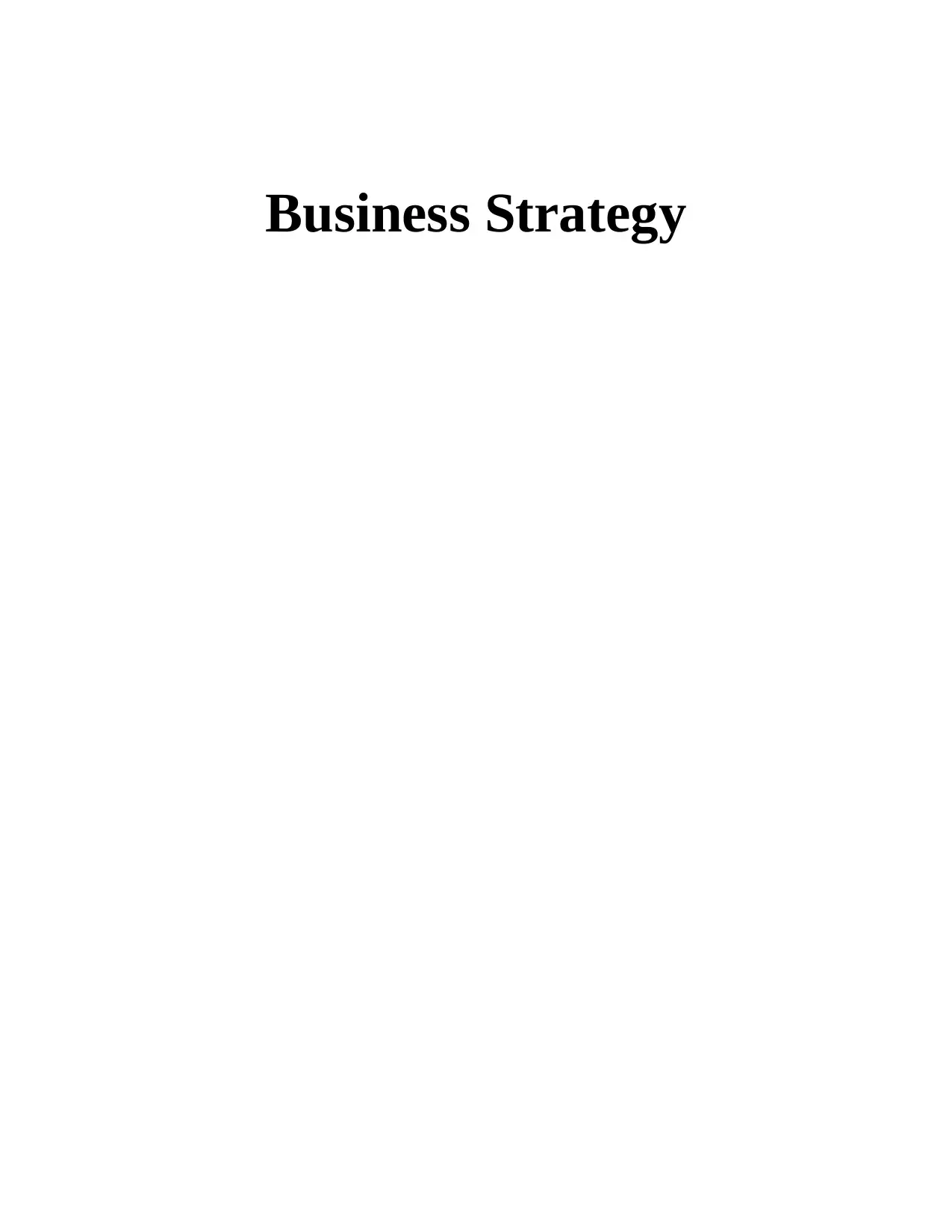
Business Strategy
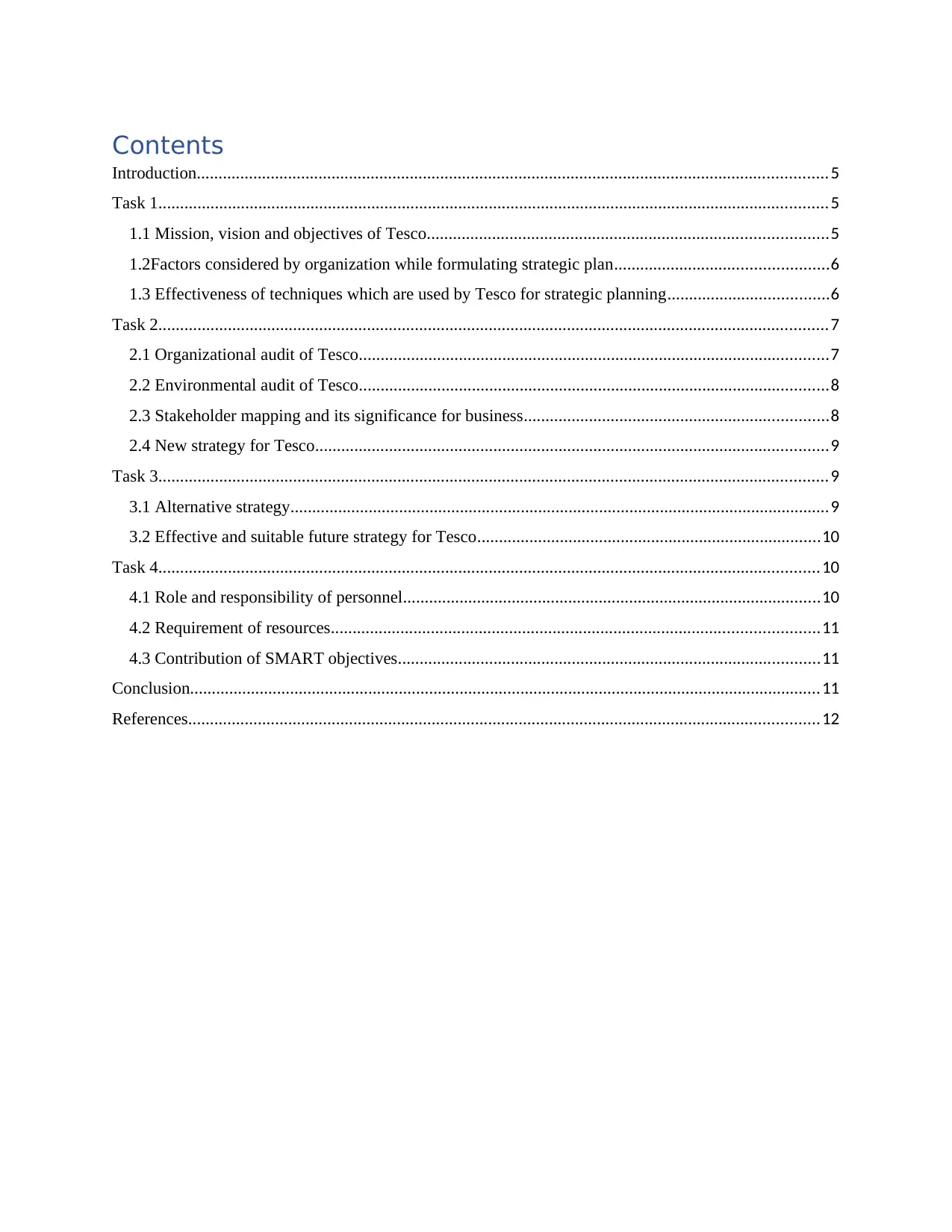
Contents
Introduction.................................................................................................................................................5
Task 1..........................................................................................................................................................5
1.1 Mission, vision and objectives of Tesco............................................................................................5
1.2Factors considered by organization while formulating strategic plan.................................................6
1.3 Effectiveness of techniques which are used by Tesco for strategic planning.....................................6
Task 2..........................................................................................................................................................7
2.1 Organizational audit of Tesco............................................................................................................7
2.2 Environmental audit of Tesco............................................................................................................8
2.3 Stakeholder mapping and its significance for business......................................................................8
2.4 New strategy for Tesco......................................................................................................................9
Task 3..........................................................................................................................................................9
3.1 Alternative strategy............................................................................................................................9
3.2 Effective and suitable future strategy for Tesco...............................................................................10
Task 4........................................................................................................................................................10
4.1 Role and responsibility of personnel................................................................................................10
4.2 Requirement of resources................................................................................................................11
4.3 Contribution of SMART objectives.................................................................................................11
Conclusion.................................................................................................................................................11
References.................................................................................................................................................12
Introduction.................................................................................................................................................5
Task 1..........................................................................................................................................................5
1.1 Mission, vision and objectives of Tesco............................................................................................5
1.2Factors considered by organization while formulating strategic plan.................................................6
1.3 Effectiveness of techniques which are used by Tesco for strategic planning.....................................6
Task 2..........................................................................................................................................................7
2.1 Organizational audit of Tesco............................................................................................................7
2.2 Environmental audit of Tesco............................................................................................................8
2.3 Stakeholder mapping and its significance for business......................................................................8
2.4 New strategy for Tesco......................................................................................................................9
Task 3..........................................................................................................................................................9
3.1 Alternative strategy............................................................................................................................9
3.2 Effective and suitable future strategy for Tesco...............................................................................10
Task 4........................................................................................................................................................10
4.1 Role and responsibility of personnel................................................................................................10
4.2 Requirement of resources................................................................................................................11
4.3 Contribution of SMART objectives.................................................................................................11
Conclusion.................................................................................................................................................11
References.................................................................................................................................................12
⊘ This is a preview!⊘
Do you want full access?
Subscribe today to unlock all pages.

Trusted by 1+ million students worldwide
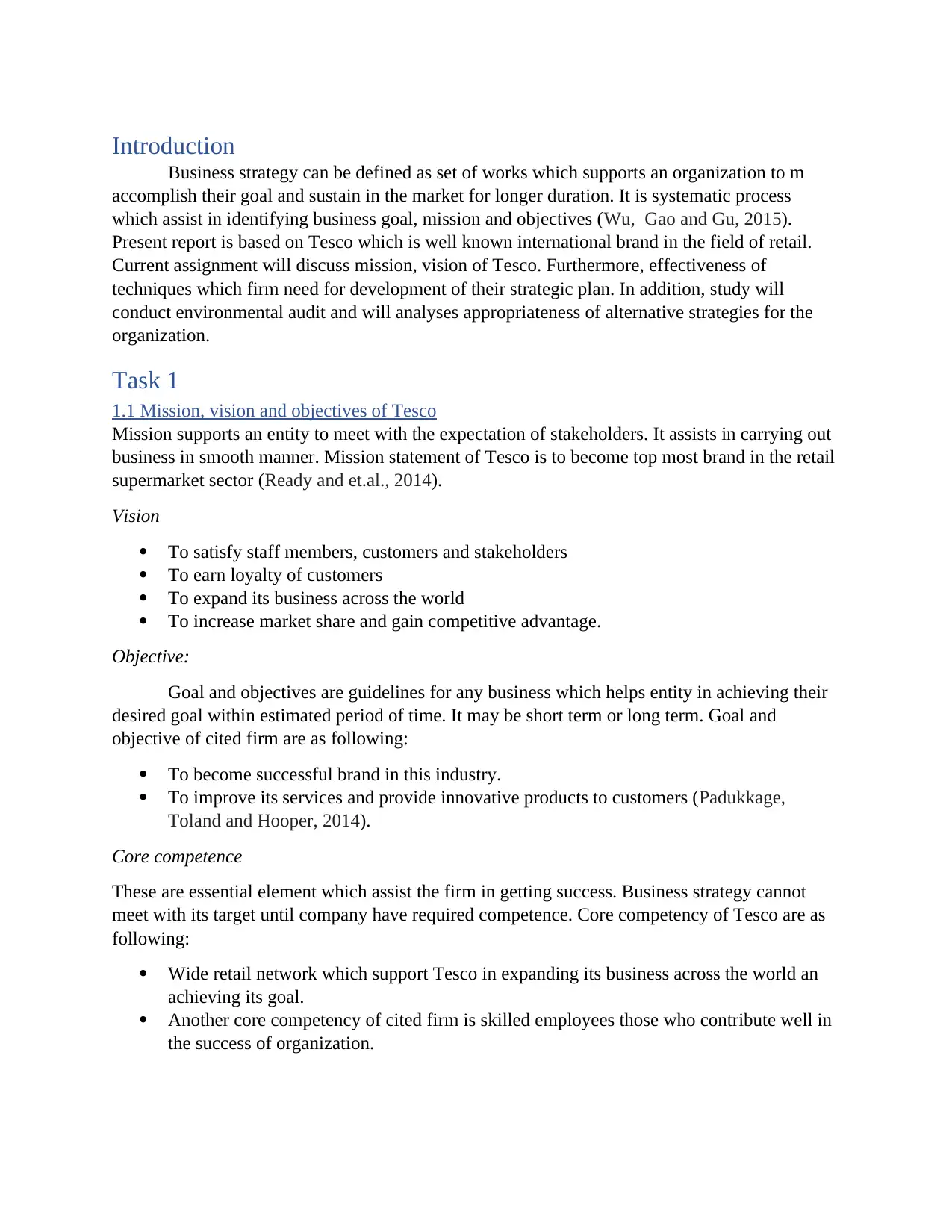
Introduction
Business strategy can be defined as set of works which supports an organization to m
accomplish their goal and sustain in the market for longer duration. It is systematic process
which assist in identifying business goal, mission and objectives (Wu, Gao and Gu, 2015).
Present report is based on Tesco which is well known international brand in the field of retail.
Current assignment will discuss mission, vision of Tesco. Furthermore, effectiveness of
techniques which firm need for development of their strategic plan. In addition, study will
conduct environmental audit and will analyses appropriateness of alternative strategies for the
organization.
Task 1
1.1 Mission, vision and objectives of Tesco
Mission supports an entity to meet with the expectation of stakeholders. It assists in carrying out
business in smooth manner. Mission statement of Tesco is to become top most brand in the retail
supermarket sector (Ready and et.al., 2014).
Vision
To satisfy staff members, customers and stakeholders
To earn loyalty of customers
To expand its business across the world
To increase market share and gain competitive advantage.
Objective:
Goal and objectives are guidelines for any business which helps entity in achieving their
desired goal within estimated period of time. It may be short term or long term. Goal and
objective of cited firm are as following:
To become successful brand in this industry.
To improve its services and provide innovative products to customers (Padukkage,
Toland and Hooper, 2014).
Core competence
These are essential element which assist the firm in getting success. Business strategy cannot
meet with its target until company have required competence. Core competency of Tesco are as
following:
Wide retail network which support Tesco in expanding its business across the world an
achieving its goal.
Another core competency of cited firm is skilled employees those who contribute well in
the success of organization.
Business strategy can be defined as set of works which supports an organization to m
accomplish their goal and sustain in the market for longer duration. It is systematic process
which assist in identifying business goal, mission and objectives (Wu, Gao and Gu, 2015).
Present report is based on Tesco which is well known international brand in the field of retail.
Current assignment will discuss mission, vision of Tesco. Furthermore, effectiveness of
techniques which firm need for development of their strategic plan. In addition, study will
conduct environmental audit and will analyses appropriateness of alternative strategies for the
organization.
Task 1
1.1 Mission, vision and objectives of Tesco
Mission supports an entity to meet with the expectation of stakeholders. It assists in carrying out
business in smooth manner. Mission statement of Tesco is to become top most brand in the retail
supermarket sector (Ready and et.al., 2014).
Vision
To satisfy staff members, customers and stakeholders
To earn loyalty of customers
To expand its business across the world
To increase market share and gain competitive advantage.
Objective:
Goal and objectives are guidelines for any business which helps entity in achieving their
desired goal within estimated period of time. It may be short term or long term. Goal and
objective of cited firm are as following:
To become successful brand in this industry.
To improve its services and provide innovative products to customers (Padukkage,
Toland and Hooper, 2014).
Core competence
These are essential element which assist the firm in getting success. Business strategy cannot
meet with its target until company have required competence. Core competency of Tesco are as
following:
Wide retail network which support Tesco in expanding its business across the world an
achieving its goal.
Another core competency of cited firm is skilled employees those who contribute well in
the success of organization.
Paraphrase This Document
Need a fresh take? Get an instant paraphrase of this document with our AI Paraphraser
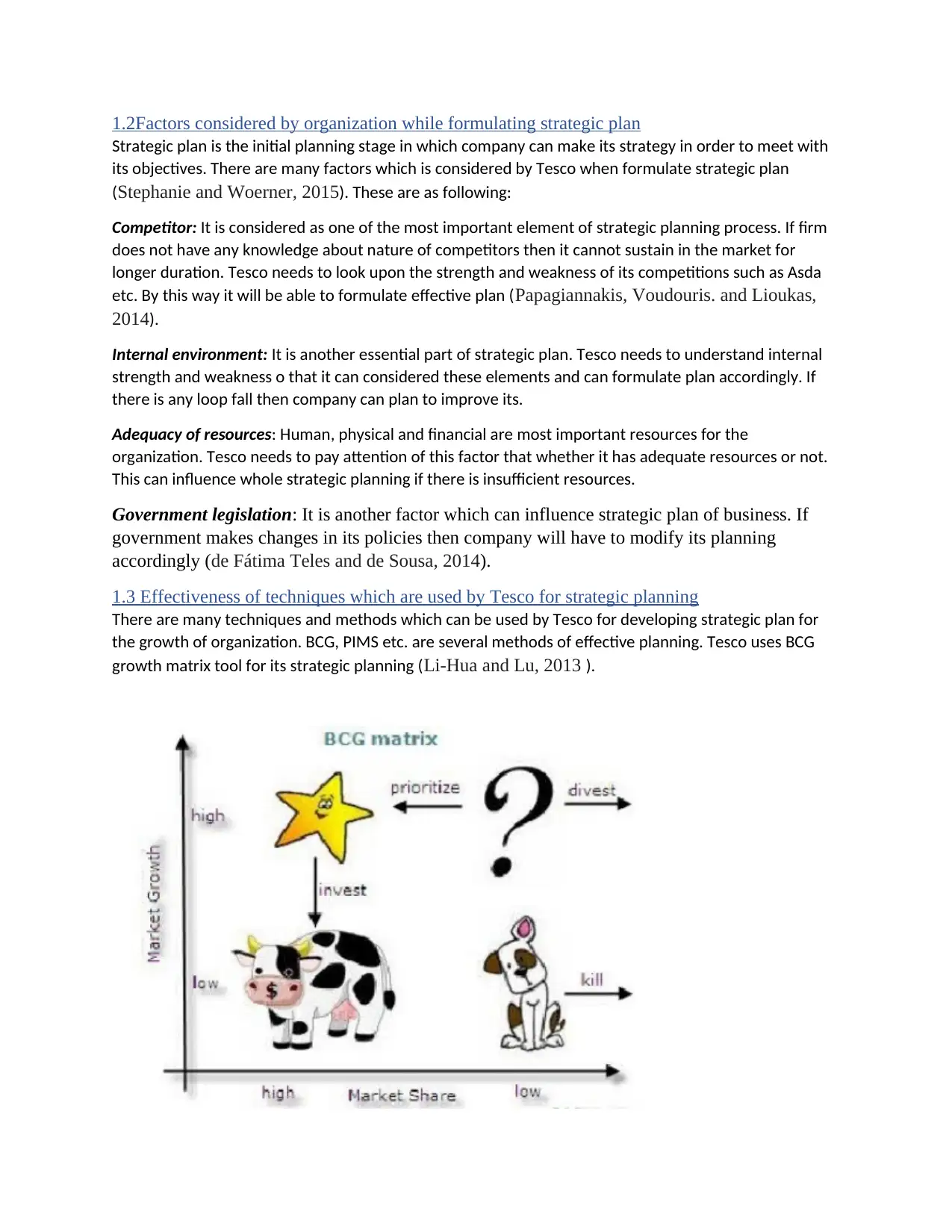
1.2Factors considered by organization while formulating strategic plan
Strategic plan is the initial planning stage in which company can make its strategy in order to meet with
its objectives. There are many factors which is considered by Tesco when formulate strategic plan
(Stephanie and Woerner, 2015). These are as following:
Competitor: It is considered as one of the most important element of strategic planning process. If firm
does not have any knowledge about nature of competitors then it cannot sustain in the market for
longer duration. Tesco needs to look upon the strength and weakness of its competitions such as Asda
etc. By this way it will be able to formulate effective plan (Papagiannakis, Voudouris. and Lioukas,
2014).
Internal environment: It is another essential part of strategic plan. Tesco needs to understand internal
strength and weakness o that it can considered these elements and can formulate plan accordingly. If
there is any loop fall then company can plan to improve its.
Adequacy of resources: Human, physical and financial are most important resources for the
organization. Tesco needs to pay attention of this factor that whether it has adequate resources or not.
This can influence whole strategic planning if there is insufficient resources.
Government legislation: It is another factor which can influence strategic plan of business. If
government makes changes in its policies then company will have to modify its planning
accordingly (de Fátima Teles and de Sousa, 2014).
1.3 Effectiveness of techniques which are used by Tesco for strategic planning
There are many techniques and methods which can be used by Tesco for developing strategic plan for
the growth of organization. BCG, PIMS etc. are several methods of effective planning. Tesco uses BCG
growth matrix tool for its strategic planning (Li-Hua and Lu, 2013 ).
Strategic plan is the initial planning stage in which company can make its strategy in order to meet with
its objectives. There are many factors which is considered by Tesco when formulate strategic plan
(Stephanie and Woerner, 2015). These are as following:
Competitor: It is considered as one of the most important element of strategic planning process. If firm
does not have any knowledge about nature of competitors then it cannot sustain in the market for
longer duration. Tesco needs to look upon the strength and weakness of its competitions such as Asda
etc. By this way it will be able to formulate effective plan (Papagiannakis, Voudouris. and Lioukas,
2014).
Internal environment: It is another essential part of strategic plan. Tesco needs to understand internal
strength and weakness o that it can considered these elements and can formulate plan accordingly. If
there is any loop fall then company can plan to improve its.
Adequacy of resources: Human, physical and financial are most important resources for the
organization. Tesco needs to pay attention of this factor that whether it has adequate resources or not.
This can influence whole strategic planning if there is insufficient resources.
Government legislation: It is another factor which can influence strategic plan of business. If
government makes changes in its policies then company will have to modify its planning
accordingly (de Fátima Teles and de Sousa, 2014).
1.3 Effectiveness of techniques which are used by Tesco for strategic planning
There are many techniques and methods which can be used by Tesco for developing strategic plan for
the growth of organization. BCG, PIMS etc. are several methods of effective planning. Tesco uses BCG
growth matrix tool for its strategic planning (Li-Hua and Lu, 2013 ).
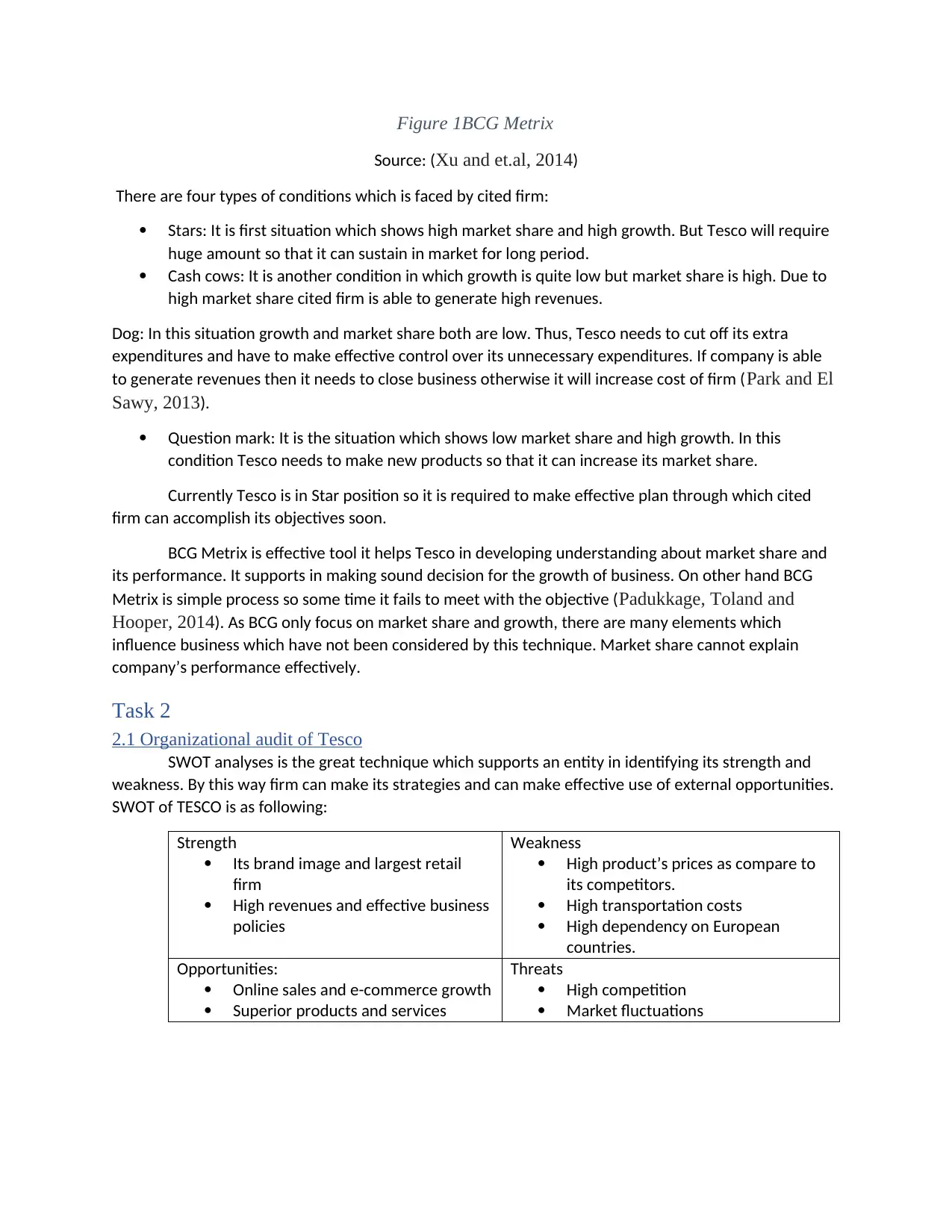
Figure 1BCG Metrix
Source: (Xu and et.al, 2014)
There are four types of conditions which is faced by cited firm:
Stars: It is first situation which shows high market share and high growth. But Tesco will require
huge amount so that it can sustain in market for long period.
Cash cows: It is another condition in which growth is quite low but market share is high. Due to
high market share cited firm is able to generate high revenues.
Dog: In this situation growth and market share both are low. Thus, Tesco needs to cut off its extra
expenditures and have to make effective control over its unnecessary expenditures. If company is able
to generate revenues then it needs to close business otherwise it will increase cost of firm (Park and El
Sawy, 2013).
Question mark: It is the situation which shows low market share and high growth. In this
condition Tesco needs to make new products so that it can increase its market share.
Currently Tesco is in Star position so it is required to make effective plan through which cited
firm can accomplish its objectives soon.
BCG Metrix is effective tool it helps Tesco in developing understanding about market share and
its performance. It supports in making sound decision for the growth of business. On other hand BCG
Metrix is simple process so some time it fails to meet with the objective (Padukkage, Toland and
Hooper, 2014). As BCG only focus on market share and growth, there are many elements which
influence business which have not been considered by this technique. Market share cannot explain
company’s performance effectively.
Task 2
2.1 Organizational audit of Tesco
SWOT analyses is the great technique which supports an entity in identifying its strength and
weakness. By this way firm can make its strategies and can make effective use of external opportunities.
SWOT of TESCO is as following:
Strength
Its brand image and largest retail
firm
High revenues and effective business
policies
Weakness
High product’s prices as compare to
its competitors.
High transportation costs
High dependency on European
countries.
Opportunities:
Online sales and e-commerce growth
Superior products and services
Threats
High competition
Market fluctuations
Source: (Xu and et.al, 2014)
There are four types of conditions which is faced by cited firm:
Stars: It is first situation which shows high market share and high growth. But Tesco will require
huge amount so that it can sustain in market for long period.
Cash cows: It is another condition in which growth is quite low but market share is high. Due to
high market share cited firm is able to generate high revenues.
Dog: In this situation growth and market share both are low. Thus, Tesco needs to cut off its extra
expenditures and have to make effective control over its unnecessary expenditures. If company is able
to generate revenues then it needs to close business otherwise it will increase cost of firm (Park and El
Sawy, 2013).
Question mark: It is the situation which shows low market share and high growth. In this
condition Tesco needs to make new products so that it can increase its market share.
Currently Tesco is in Star position so it is required to make effective plan through which cited
firm can accomplish its objectives soon.
BCG Metrix is effective tool it helps Tesco in developing understanding about market share and
its performance. It supports in making sound decision for the growth of business. On other hand BCG
Metrix is simple process so some time it fails to meet with the objective (Padukkage, Toland and
Hooper, 2014). As BCG only focus on market share and growth, there are many elements which
influence business which have not been considered by this technique. Market share cannot explain
company’s performance effectively.
Task 2
2.1 Organizational audit of Tesco
SWOT analyses is the great technique which supports an entity in identifying its strength and
weakness. By this way firm can make its strategies and can make effective use of external opportunities.
SWOT of TESCO is as following:
Strength
Its brand image and largest retail
firm
High revenues and effective business
policies
Weakness
High product’s prices as compare to
its competitors.
High transportation costs
High dependency on European
countries.
Opportunities:
Online sales and e-commerce growth
Superior products and services
Threats
High competition
Market fluctuations
⊘ This is a preview!⊘
Do you want full access?
Subscribe today to unlock all pages.

Trusted by 1+ million students worldwide
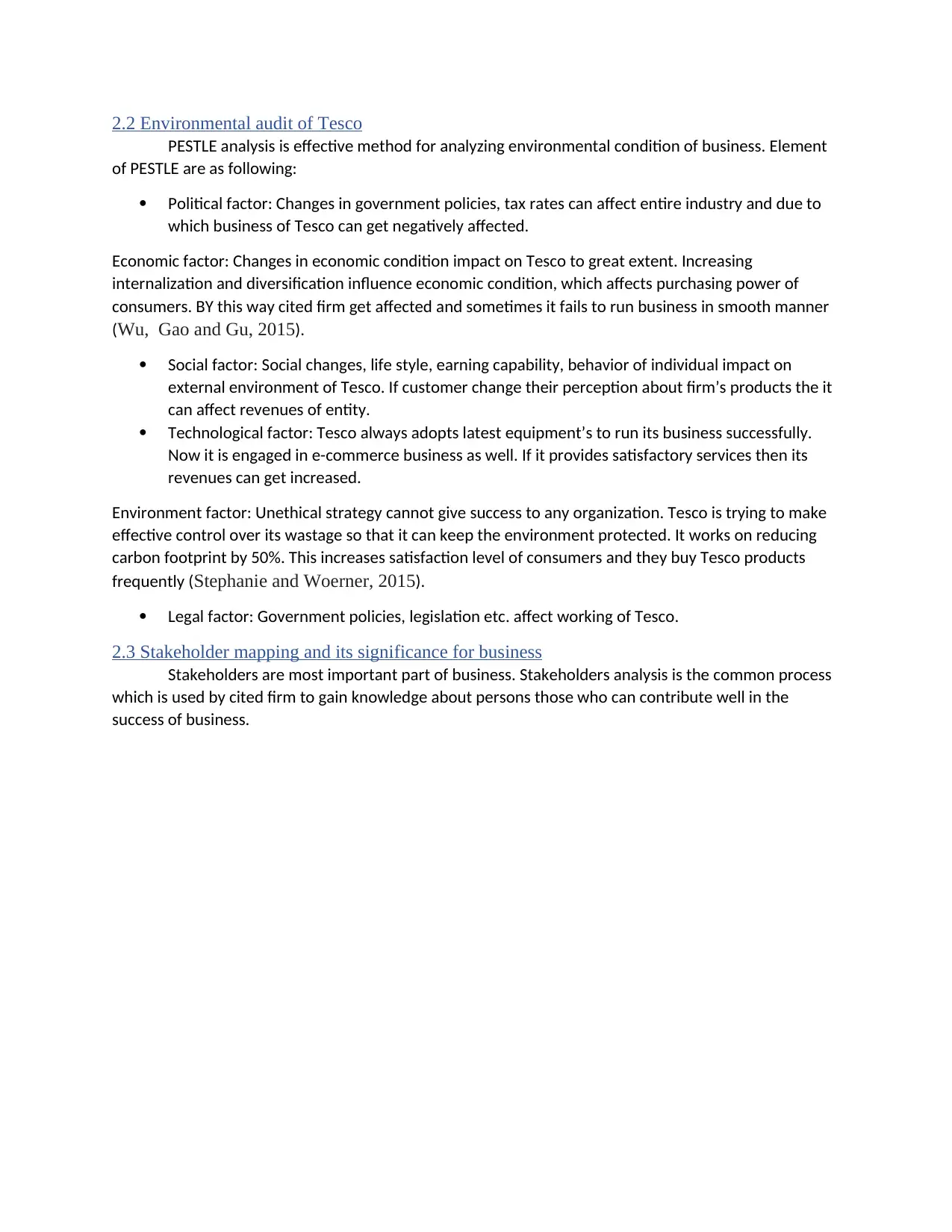
2.2 Environmental audit of Tesco
PESTLE analysis is effective method for analyzing environmental condition of business. Element
of PESTLE are as following:
Political factor: Changes in government policies, tax rates can affect entire industry and due to
which business of Tesco can get negatively affected.
Economic factor: Changes in economic condition impact on Tesco to great extent. Increasing
internalization and diversification influence economic condition, which affects purchasing power of
consumers. BY this way cited firm get affected and sometimes it fails to run business in smooth manner
(Wu, Gao and Gu, 2015).
Social factor: Social changes, life style, earning capability, behavior of individual impact on
external environment of Tesco. If customer change their perception about firm’s products the it
can affect revenues of entity.
Technological factor: Tesco always adopts latest equipment’s to run its business successfully.
Now it is engaged in e-commerce business as well. If it provides satisfactory services then its
revenues can get increased.
Environment factor: Unethical strategy cannot give success to any organization. Tesco is trying to make
effective control over its wastage so that it can keep the environment protected. It works on reducing
carbon footprint by 50%. This increases satisfaction level of consumers and they buy Tesco products
frequently (Stephanie and Woerner, 2015).
Legal factor: Government policies, legislation etc. affect working of Tesco.
2.3 Stakeholder mapping and its significance for business
Stakeholders are most important part of business. Stakeholders analysis is the common process
which is used by cited firm to gain knowledge about persons those who can contribute well in the
success of business.
PESTLE analysis is effective method for analyzing environmental condition of business. Element
of PESTLE are as following:
Political factor: Changes in government policies, tax rates can affect entire industry and due to
which business of Tesco can get negatively affected.
Economic factor: Changes in economic condition impact on Tesco to great extent. Increasing
internalization and diversification influence economic condition, which affects purchasing power of
consumers. BY this way cited firm get affected and sometimes it fails to run business in smooth manner
(Wu, Gao and Gu, 2015).
Social factor: Social changes, life style, earning capability, behavior of individual impact on
external environment of Tesco. If customer change their perception about firm’s products the it
can affect revenues of entity.
Technological factor: Tesco always adopts latest equipment’s to run its business successfully.
Now it is engaged in e-commerce business as well. If it provides satisfactory services then its
revenues can get increased.
Environment factor: Unethical strategy cannot give success to any organization. Tesco is trying to make
effective control over its wastage so that it can keep the environment protected. It works on reducing
carbon footprint by 50%. This increases satisfaction level of consumers and they buy Tesco products
frequently (Stephanie and Woerner, 2015).
Legal factor: Government policies, legislation etc. affect working of Tesco.
2.3 Stakeholder mapping and its significance for business
Stakeholders are most important part of business. Stakeholders analysis is the common process
which is used by cited firm to gain knowledge about persons those who can contribute well in the
success of business.
Paraphrase This Document
Need a fresh take? Get an instant paraphrase of this document with our AI Paraphraser
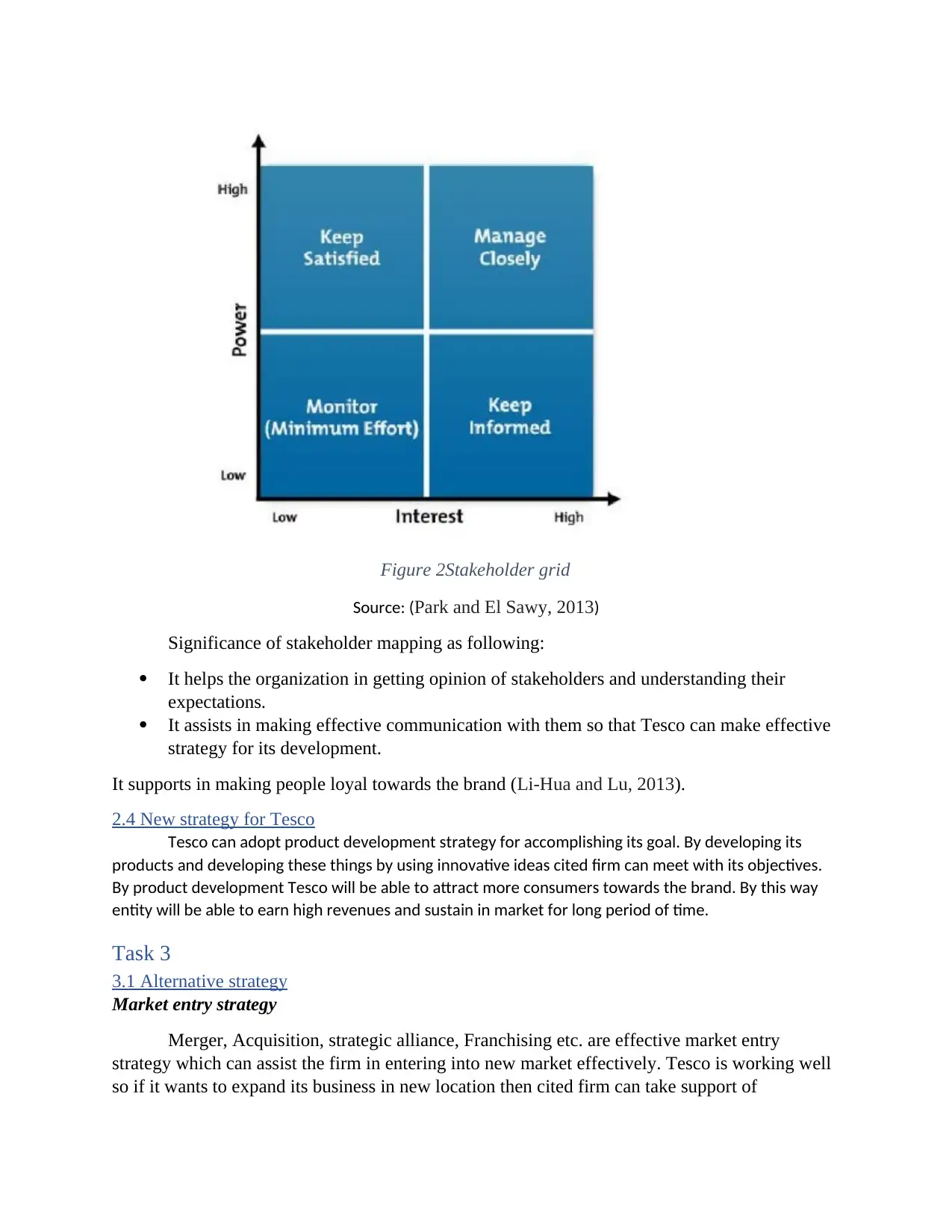
Figure 2Stakeholder grid
Source: (Park and El Sawy, 2013)
Significance of stakeholder mapping as following:
It helps the organization in getting opinion of stakeholders and understanding their
expectations.
It assists in making effective communication with them so that Tesco can make effective
strategy for its development.
It supports in making people loyal towards the brand (Li-Hua and Lu, 2013).
2.4 New strategy for Tesco
Tesco can adopt product development strategy for accomplishing its goal. By developing its
products and developing these things by using innovative ideas cited firm can meet with its objectives.
By product development Tesco will be able to attract more consumers towards the brand. By this way
entity will be able to earn high revenues and sustain in market for long period of time.
Task 3
3.1 Alternative strategy
Market entry strategy
Merger, Acquisition, strategic alliance, Franchising etc. are effective market entry
strategy which can assist the firm in entering into new market effectively. Tesco is working well
so if it wants to expand its business in new location then cited firm can take support of
Source: (Park and El Sawy, 2013)
Significance of stakeholder mapping as following:
It helps the organization in getting opinion of stakeholders and understanding their
expectations.
It assists in making effective communication with them so that Tesco can make effective
strategy for its development.
It supports in making people loyal towards the brand (Li-Hua and Lu, 2013).
2.4 New strategy for Tesco
Tesco can adopt product development strategy for accomplishing its goal. By developing its
products and developing these things by using innovative ideas cited firm can meet with its objectives.
By product development Tesco will be able to attract more consumers towards the brand. By this way
entity will be able to earn high revenues and sustain in market for long period of time.
Task 3
3.1 Alternative strategy
Market entry strategy
Merger, Acquisition, strategic alliance, Franchising etc. are effective market entry
strategy which can assist the firm in entering into new market effectively. Tesco is working well
so if it wants to expand its business in new location then cited firm can take support of
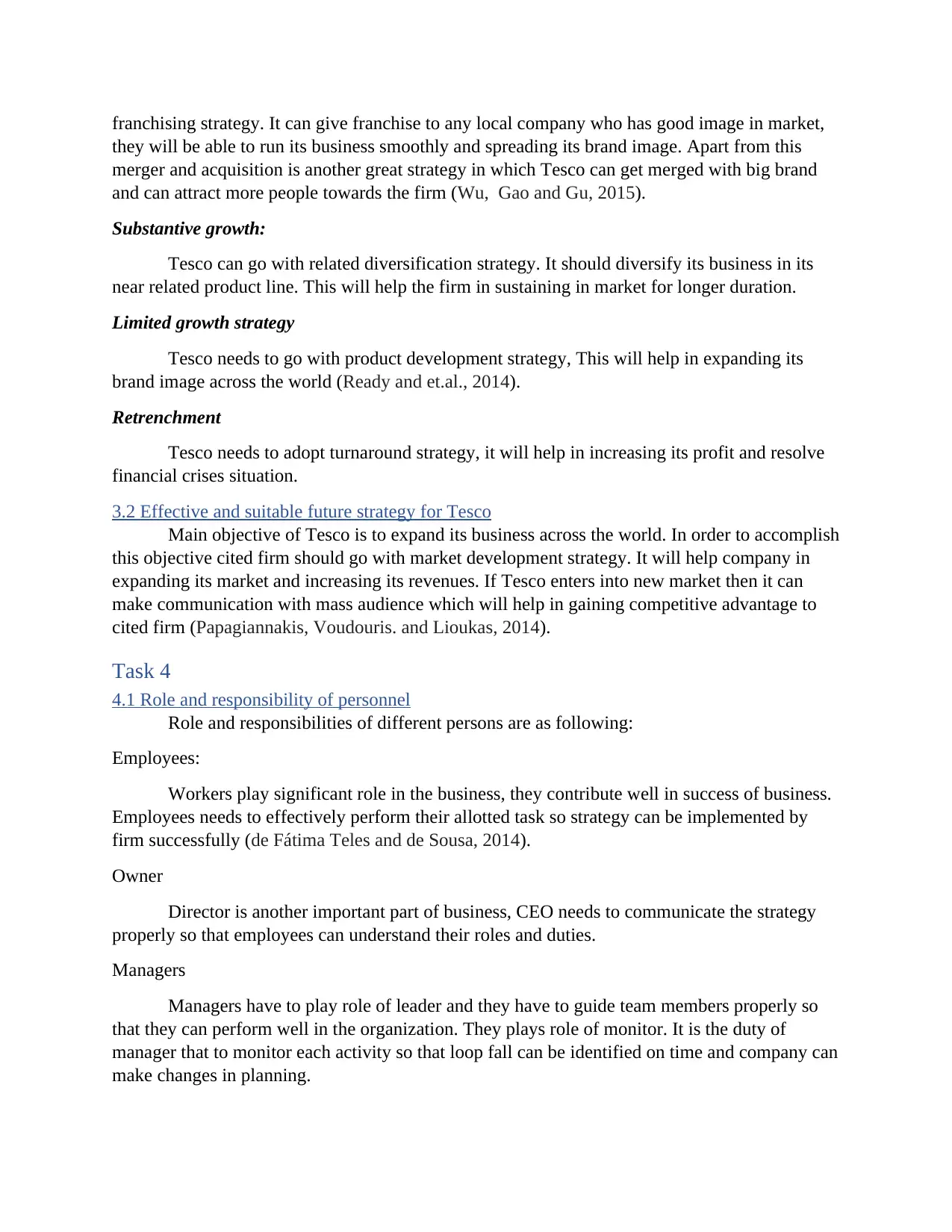
franchising strategy. It can give franchise to any local company who has good image in market,
they will be able to run its business smoothly and spreading its brand image. Apart from this
merger and acquisition is another great strategy in which Tesco can get merged with big brand
and can attract more people towards the firm (Wu, Gao and Gu, 2015).
Substantive growth:
Tesco can go with related diversification strategy. It should diversify its business in its
near related product line. This will help the firm in sustaining in market for longer duration.
Limited growth strategy
Tesco needs to go with product development strategy, This will help in expanding its
brand image across the world (Ready and et.al., 2014).
Retrenchment
Tesco needs to adopt turnaround strategy, it will help in increasing its profit and resolve
financial crises situation.
3.2 Effective and suitable future strategy for Tesco
Main objective of Tesco is to expand its business across the world. In order to accomplish
this objective cited firm should go with market development strategy. It will help company in
expanding its market and increasing its revenues. If Tesco enters into new market then it can
make communication with mass audience which will help in gaining competitive advantage to
cited firm (Papagiannakis, Voudouris. and Lioukas, 2014).
Task 4
4.1 Role and responsibility of personnel
Role and responsibilities of different persons are as following:
Employees:
Workers play significant role in the business, they contribute well in success of business.
Employees needs to effectively perform their allotted task so strategy can be implemented by
firm successfully (de Fátima Teles and de Sousa, 2014).
Owner
Director is another important part of business, CEO needs to communicate the strategy
properly so that employees can understand their roles and duties.
Managers
Managers have to play role of leader and they have to guide team members properly so
that they can perform well in the organization. They plays role of monitor. It is the duty of
manager that to monitor each activity so that loop fall can be identified on time and company can
make changes in planning.
they will be able to run its business smoothly and spreading its brand image. Apart from this
merger and acquisition is another great strategy in which Tesco can get merged with big brand
and can attract more people towards the firm (Wu, Gao and Gu, 2015).
Substantive growth:
Tesco can go with related diversification strategy. It should diversify its business in its
near related product line. This will help the firm in sustaining in market for longer duration.
Limited growth strategy
Tesco needs to go with product development strategy, This will help in expanding its
brand image across the world (Ready and et.al., 2014).
Retrenchment
Tesco needs to adopt turnaround strategy, it will help in increasing its profit and resolve
financial crises situation.
3.2 Effective and suitable future strategy for Tesco
Main objective of Tesco is to expand its business across the world. In order to accomplish
this objective cited firm should go with market development strategy. It will help company in
expanding its market and increasing its revenues. If Tesco enters into new market then it can
make communication with mass audience which will help in gaining competitive advantage to
cited firm (Papagiannakis, Voudouris. and Lioukas, 2014).
Task 4
4.1 Role and responsibility of personnel
Role and responsibilities of different persons are as following:
Employees:
Workers play significant role in the business, they contribute well in success of business.
Employees needs to effectively perform their allotted task so strategy can be implemented by
firm successfully (de Fátima Teles and de Sousa, 2014).
Owner
Director is another important part of business, CEO needs to communicate the strategy
properly so that employees can understand their roles and duties.
Managers
Managers have to play role of leader and they have to guide team members properly so
that they can perform well in the organization. They plays role of monitor. It is the duty of
manager that to monitor each activity so that loop fall can be identified on time and company can
make changes in planning.
⊘ This is a preview!⊘
Do you want full access?
Subscribe today to unlock all pages.

Trusted by 1+ million students worldwide

4.2 Requirement of resources
Tesco is required to have sufficient resources to implement strategy effectively. Resources
require for implementation of strategy are as following:
Human resource: Cited firm needs skill employees those who can contribute well in the success
of business. With the help of talented staff members company will be able to meet with its
objectives.
Financial resources: Tesco requires funds for successfully implementation of strategy. Cited firm can
take support of equity funds because by this way kit will be able to raise capital and controlling over
liabilities (Park and El Sawy, 2013).
Time and material resources: It is another main resource, cited firm needs sufficient time so
that it can implement plan properly. Apart from this company is required sufficient equipment’s,
tools, technology, machines so that it can improve its output and can increase satisfaction level
of customers.
4.3 Contribution of SMART objectives
SMART objectives are helpful in accomplishing goal of the organization. SMART
objective of Tesco is:
To increase market share by 30% till the end of 2018.
To enhance satisfaction level of clients and increase number of customers by 40% till mid of
2018 (Xu and et.al, 2014).
These objective supports in achievement of company. As these objectives are bounded
under time period so Tesco will be able to fulfill its long-term goal within estimated period of
time. It supports in identify priorities and moving towards right direction. By making SMART
objectives cited firm can allocate responsibility effectively and workers can perform their duties
well. Measurable, specific objectives assist the entity in minimizing wastage and utilize funds
effectively (de Fátima Teles and de Sousa, 2014).
Conclusion
From the above report it can be concluded that Tesco has hold number one position in the
retail sector but to sustain in the market for longer duration cited firm should make effective
business strategy. Merger and product development are great strategies through which cited firm
can meet with its goal.
Tesco is required to have sufficient resources to implement strategy effectively. Resources
require for implementation of strategy are as following:
Human resource: Cited firm needs skill employees those who can contribute well in the success
of business. With the help of talented staff members company will be able to meet with its
objectives.
Financial resources: Tesco requires funds for successfully implementation of strategy. Cited firm can
take support of equity funds because by this way kit will be able to raise capital and controlling over
liabilities (Park and El Sawy, 2013).
Time and material resources: It is another main resource, cited firm needs sufficient time so
that it can implement plan properly. Apart from this company is required sufficient equipment’s,
tools, technology, machines so that it can improve its output and can increase satisfaction level
of customers.
4.3 Contribution of SMART objectives
SMART objectives are helpful in accomplishing goal of the organization. SMART
objective of Tesco is:
To increase market share by 30% till the end of 2018.
To enhance satisfaction level of clients and increase number of customers by 40% till mid of
2018 (Xu and et.al, 2014).
These objective supports in achievement of company. As these objectives are bounded
under time period so Tesco will be able to fulfill its long-term goal within estimated period of
time. It supports in identify priorities and moving towards right direction. By making SMART
objectives cited firm can allocate responsibility effectively and workers can perform their duties
well. Measurable, specific objectives assist the entity in minimizing wastage and utilize funds
effectively (de Fátima Teles and de Sousa, 2014).
Conclusion
From the above report it can be concluded that Tesco has hold number one position in the
retail sector but to sustain in the market for longer duration cited firm should make effective
business strategy. Merger and product development are great strategies through which cited firm
can meet with its goal.
Paraphrase This Document
Need a fresh take? Get an instant paraphrase of this document with our AI Paraphraser
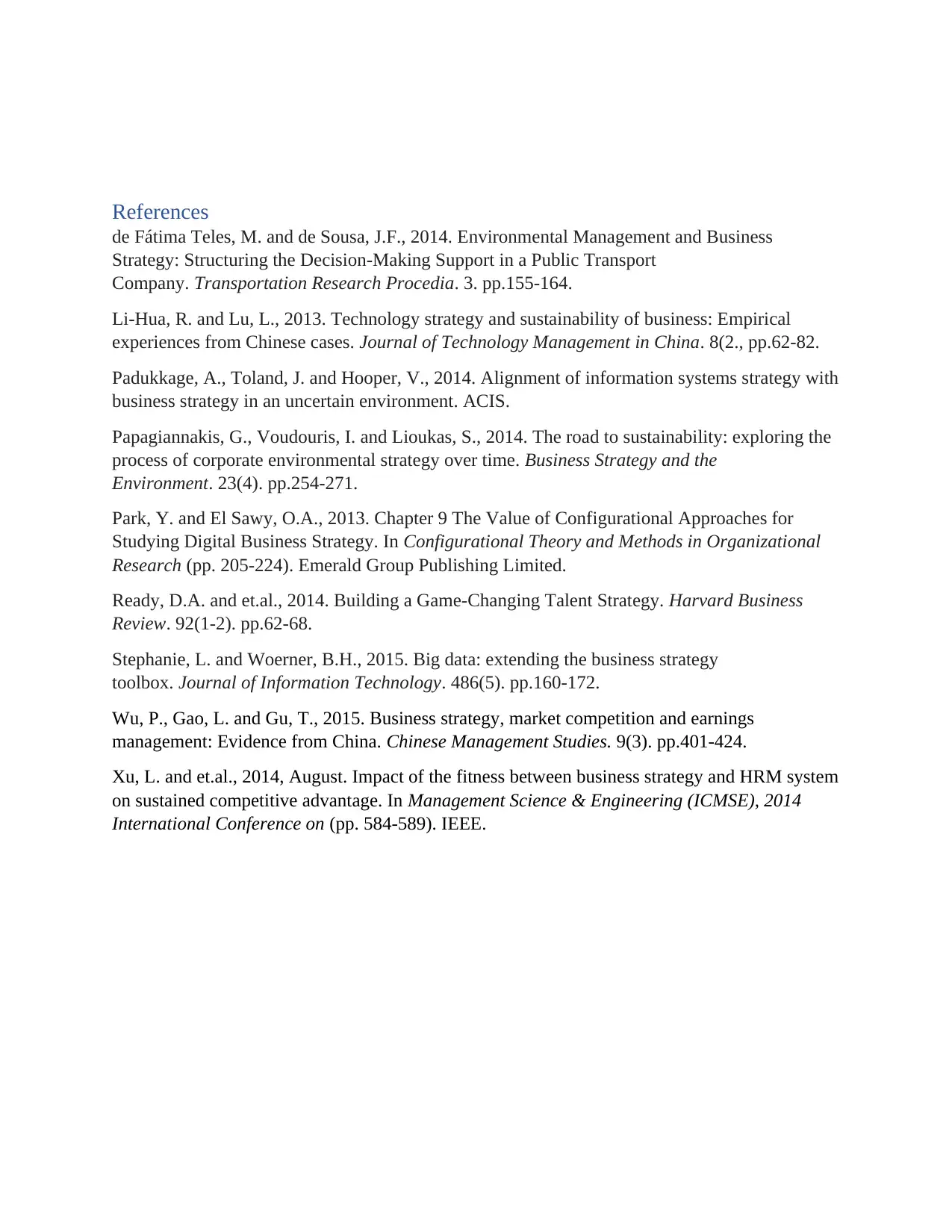
References
de Fátima Teles, M. and de Sousa, J.F., 2014. Environmental Management and Business
Strategy: Structuring the Decision-Making Support in a Public Transport
Company. Transportation Research Procedia. 3. pp.155-164.
Li-Hua, R. and Lu, L., 2013. Technology strategy and sustainability of business: Empirical
experiences from Chinese cases. Journal of Technology Management in China. 8(2., pp.62-82.
Padukkage, A., Toland, J. and Hooper, V., 2014. Alignment of information systems strategy with
business strategy in an uncertain environment. ACIS.
Papagiannakis, G., Voudouris, I. and Lioukas, S., 2014. The road to sustainability: exploring the
process of corporate environmental strategy over time. Business Strategy and the
Environment. 23(4). pp.254-271.
Park, Y. and El Sawy, O.A., 2013. Chapter 9 The Value of Configurational Approaches for
Studying Digital Business Strategy. In Configurational Theory and Methods in Organizational
Research (pp. 205-224). Emerald Group Publishing Limited.
Ready, D.A. and et.al., 2014. Building a Game-Changing Talent Strategy. Harvard Business
Review. 92(1-2). pp.62-68.
Stephanie, L. and Woerner, B.H., 2015. Big data: extending the business strategy
toolbox. Journal of Information Technology. 486(5). pp.160-172.
Wu, P., Gao, L. and Gu, T., 2015. Business strategy, market competition and earnings
management: Evidence from China. Chinese Management Studies. 9(3). pp.401-424.
Xu, L. and et.al., 2014, August. Impact of the fitness between business strategy and HRM system
on sustained competitive advantage. In Management Science & Engineering (ICMSE), 2014
International Conference on (pp. 584-589). IEEE.
de Fátima Teles, M. and de Sousa, J.F., 2014. Environmental Management and Business
Strategy: Structuring the Decision-Making Support in a Public Transport
Company. Transportation Research Procedia. 3. pp.155-164.
Li-Hua, R. and Lu, L., 2013. Technology strategy and sustainability of business: Empirical
experiences from Chinese cases. Journal of Technology Management in China. 8(2., pp.62-82.
Padukkage, A., Toland, J. and Hooper, V., 2014. Alignment of information systems strategy with
business strategy in an uncertain environment. ACIS.
Papagiannakis, G., Voudouris, I. and Lioukas, S., 2014. The road to sustainability: exploring the
process of corporate environmental strategy over time. Business Strategy and the
Environment. 23(4). pp.254-271.
Park, Y. and El Sawy, O.A., 2013. Chapter 9 The Value of Configurational Approaches for
Studying Digital Business Strategy. In Configurational Theory and Methods in Organizational
Research (pp. 205-224). Emerald Group Publishing Limited.
Ready, D.A. and et.al., 2014. Building a Game-Changing Talent Strategy. Harvard Business
Review. 92(1-2). pp.62-68.
Stephanie, L. and Woerner, B.H., 2015. Big data: extending the business strategy
toolbox. Journal of Information Technology. 486(5). pp.160-172.
Wu, P., Gao, L. and Gu, T., 2015. Business strategy, market competition and earnings
management: Evidence from China. Chinese Management Studies. 9(3). pp.401-424.
Xu, L. and et.al., 2014, August. Impact of the fitness between business strategy and HRM system
on sustained competitive advantage. In Management Science & Engineering (ICMSE), 2014
International Conference on (pp. 584-589). IEEE.
1 out of 11
Related Documents
Your All-in-One AI-Powered Toolkit for Academic Success.
+13062052269
info@desklib.com
Available 24*7 on WhatsApp / Email
![[object Object]](/_next/static/media/star-bottom.7253800d.svg)
Unlock your academic potential
Copyright © 2020–2025 A2Z Services. All Rights Reserved. Developed and managed by ZUCOL.





